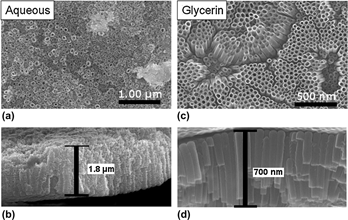Article contents
A comparative study of anodized titania nanotube architectures in aqueous and nonaqueous solutions
Published online by Cambridge University Press: 24 August 2011
Abstract

The unique and highly utilized properties of TiO2 nanotubes are a direct result of nanotube architecture. To create different engineered architectures, the effects of electrolyte solution, time, and temperature on the anodization of titanium foil were studied along with the resultant anodized titanium oxide (ATO) nanotube architectures encompassing nanotube length, pore diameter, wall thickness, smoothness, and ordered array structure. Titanium foil was anodized in three different electrolyte solutions: one aqueous [consisting of NH4F and (NH4)2SO4] and two nonaqueous (glycerol or ethylene glycol, both containing NH4F) at varying temperatures and anodization times. Variation in anodization applied voltage, initial current, and effect of F− ion concentration on ATO nanotube architecture was also studied. Anodization in the aqueous electrolyte produced short, rough nanotube arrays, whereas anodization in organic electrolytes produced long, smooth nanotube arrays greater than 10 μm in length. A position effect, relative to the solution–air interface, was observed in this work. Furthermore, it was found that anodization in glycerol at elevated temperatures for several hours could possibly produce freely dispersed individual nanotubes.
- Type
- Articles
- Information
- Copyright
- Copyright © Materials Research Society 2011
References
REFERENCES
- 11
- Cited by




